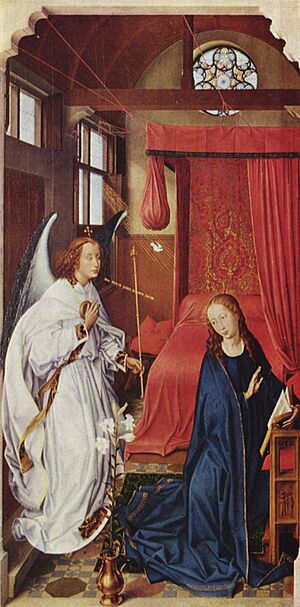Saint Columba Altarpiece facts for kids
The Saint Columba Altarpiece (also known as the Adoration of the Kings) is a large painting from around 1455. It was created by Rogier van der Weyden, a famous painter from the Early Netherlandish period. Today, you can see this artwork at the Alte Pinakothek museum in Munich, Germany.
This altarpiece is made up of three wooden panels painted with oil. It tells a story from the Bible in three parts:
- The left panel shows the Annunciation, when the archangel Gabriel visits Mary.
- The middle panel shows the Adoration of the Magi, where wise men visit Christ after his birth.
- The right panel shows the Presentation in the Temple, when Mary and Joseph present baby Jesus at the temple.
Exploring the Panels
Each part of the altarpiece is full of interesting details and symbols. For example, in the Annunciation panel, where Mary is kneeling, you can see a small carving on her prayer stand. This carving shows the Fall of Man, a story from the Bible.
In the middle panel, which shows Jesus's birth, there's a tiny crucifix hanging on a pillar behind Mary. This is interesting because the cross represents Jesus's death, which happened many years after his birth.
The person who paid for this painting, called the donor, is shown on the left side of the middle panel. He is kneeling in front of a wide landscape.
One very clever thing about this altarpiece is how it connects the scenes. On the far right of the middle panel, you can see the outside of a building. This is the same building that appears on the right panel, but there you see its inside! This helps the story flow from one panel to the next, even though the stable (where Jesus was born) was in Bethlehem and the Temple was in Jerusalem. It was a new way for artists to show a story moving through different places and times.
The Presentation scene on the right panel takes place inside this large, round building. The artist used bold lines and angles to make the space look very grand and deep.
The back of the altarpiece panels are plain. They were never painted with pictures or portraits.
The Saint Columba Altarpiece was very popular. Many artists in the 1400s and 1500s made copies of it. It even inspired other famous painters like Hans Memling, who created his Triptych of Jan Floreins after seeing this work.
How the Painting Was Ordered
This altarpiece was first mentioned in records from 1801 at the St. Kolumba church in Cologne, Germany. It was kept in the private chapel of the von dem Wasservass family. It is believed that Goddert von dem Wasservass, who was a mayor of Cologne, ordered the painting in the 1460s.
Experts believe the altarpiece stayed in this private chapel until 1801. Later, in 1808, two brothers named Sulpiz and Melchior Boisseree bought it for their art collection. In 1827, their collection was bought by the Alte Pinakothek museum, where the altarpiece is still displayed today.
See also
 In Spanish: Tríptico del altar de Santa Columba para niños
In Spanish: Tríptico del altar de Santa Columba para niños


